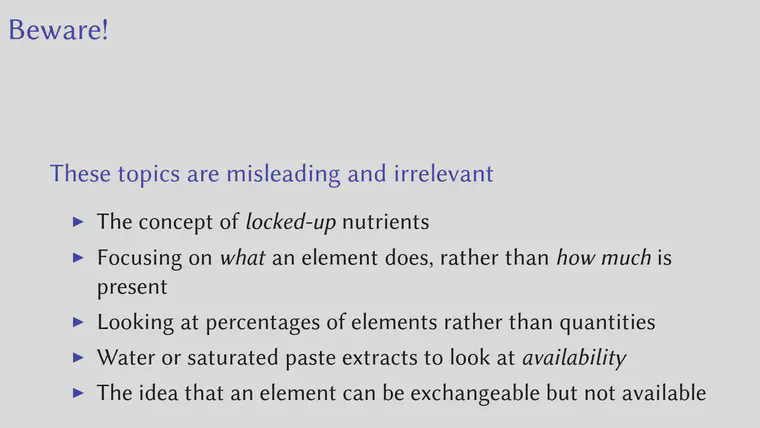Beware! These topics are misleading and irrelevant
In July 2015 I led a seminar entitled “A discussion mostly about the principles of turfgrass nutrition, with a focus on soil nutrient analyses and their use in modern turf management.” The slides for this seminar are available in English and in Japanese.
I usually talk about how one should do things, but in this presentation, I spoke for a while about how not to do things, with the list on this slide.

Why are each of these misleading and irrelevant?
- The concept of locked-up nutrients
- Nutrients in the soil may be relatively more or less available, but that is what a soil test evaluates. After a soil test (and a technical term for that is a nutrient availability analysis) has been conducted, one compares the test result to a guideline level. I recommend using the MLSN guidelines. Once the test is done, and the results are compared to the guideline, one knows the availability. That is all one needs to know. If nutrients are locked-up to the extent that the plant can’t use them, that will be evident on the soil test result.
- Focusing on what an element does, rather than how much is present
- Phosphorus is crucial for root development, potassium is key to stomatal regulation, magnesium is at the center of the chlorophyll molecule, and calcium is essential for cell wall structure. All true, but also beside the point. What is important is that there is enough of each of those elements, not what those elements do. If there is enough phosphorus, all the root development benefits will proceed as they should. And so it goes for the other elements. The important thing to focus on is the quantity of elements available. Soil testing, and comparing the results to the MLSN guidelines, does just that.
- Looking at percentages of elements rather than quantities
- The quantity of an element available is what is important, and that will be expressed as either a concentration in the soil (for example as parts of element per million parts of soil—ppm) or as a mass of element per surface area (for example as g m-2). Percentages of elements, or ratios of elements, don’t provide the necessary information, and are not how one should look at soil test results. For more, see Nutritionism by John Foy and this review on cation ratios.
- Water or saturated paste extracts to look at availability
- The information in a water extract of soil is already contained in the standard (for example, Mehlich 3 or ammonium acetate extractant) test result. Take the same identical soil, divide into two sub-samples, modify the water soluble nutrients in one, and not the other, and then perform a regular soil test. The test results will show how the water soluble nutrients differ from one sub-sample to the next. A regular soil test already provides all this information. Water (or saturated paste) tests are good for research or for assessing soil salinity. They are not useful for determining how much fertilizer to apply. Carrow et al. wrote about this and offer this advice: “SPE [a saturated paste extract] is not the best method for determining soil fertility levels and can be very misleading.”
- The idea that an element can be exchangeable but not available
- This is an insidious combination of 2 errors listed above: thinking of locked-up nutrients and the misuse of water extracts.
That’s enough about how not to do it. For more about how to do soil testing, determine nutrient availability, and calculate how much fertilizer to apply, see: